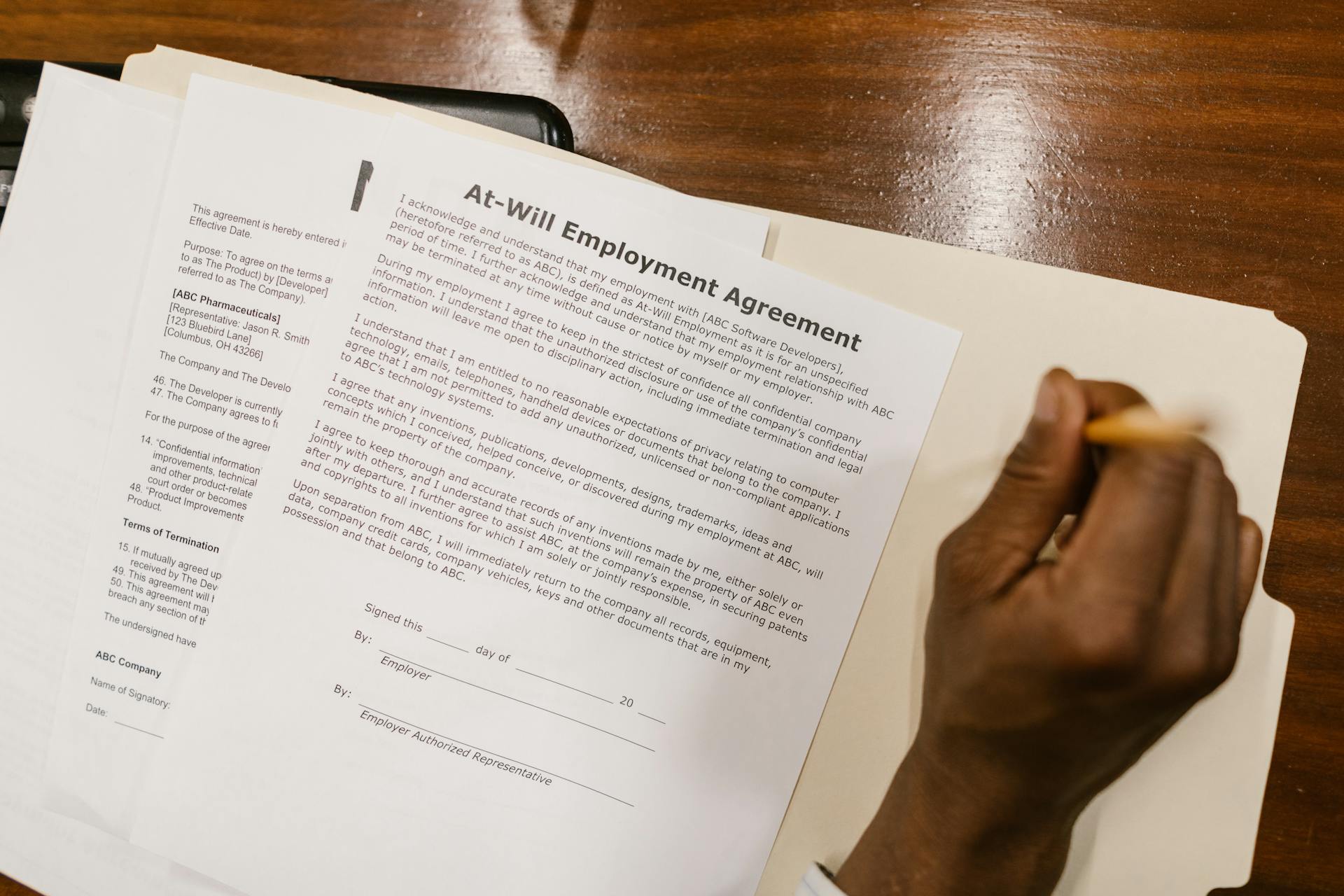
The SF Employer Mandate has significant implications for local businesses. Small businesses with 20 or more employees must provide health insurance or pay a fee, which can be a substantial burden.
This mandate can affect a business's bottom line, with some companies reporting an increase in costs of up to 10%. The city estimates that 90% of small businesses will be affected by the mandate.
To comply with the mandate, businesses must offer health insurance that meets certain minimum requirements, including covering 80% of medical expenses.
What Is the SF Employer Mandate?
The SF Employer Mandate is a requirement for certain employers to contribute to their employees' healthcare expenses. It's a bit complex, but I'll break it down for you.
A Covered Employer is defined as a for-profit entity with 20 or more workers or a nonprofit entity with 50 or more workers. This includes all employees, regardless of their classification.
To be considered a Covered Employee, an individual must work for a Covered Employer within the city or county of San Francisco for at least eight hours per week on average during the calendar quarter. They must also be entitled to be paid the minimum wage and have worked for the Covered Employer for at least 90 calendar days.
Take a look at this: Workers Compensation Employers Liability Coverage

The SF Employer Mandate requires Covered Employers to make certain minimum Health Care Expenditures on a quarterly basis for their Covered Employees. This is calculated by multiplying the Annual Health Care Expenditure Rate by the hours in the calendar quarter the Covered Employee was paid wages for work performed or for which they are otherwise entitled to pay.
Here's a breakdown of how the calculation works:
- Multiply the Annual Health Care Expenditure Rate by the hours in the calendar quarter the Covered Employee was paid wages for work performed or for which they are otherwise entitled to pay (capped at 172 hours per month)
- The result must be separately calculated for each Covered Employee
- The Covered Employer must contribute the required Health Care Expenditure dollar amount as calculated for each Covered Employee
Covered Employers can choose from several options to fulfill their Health Care Expenditure requirement, including providing private insurance, paying into a reimbursement account, or contributing to Healthy San Francisco.
Employer Reaction and Compliance
Most employers in San Francisco had to increase health spending to comply with the pay-or-play employer health spending mandate, with 75% of employers affected.
The law was surprisingly well-received by employers, with 64% expressing support for it.
For another approach, see: Flex Spending Account Rules Termination Employment
Employer Reaction to Pay-or-Play Mandate
Employers in San Francisco were required to increase health spending to comply with the pay-or-play mandate, with 75% having to pay more. This was a significant change for many businesses.
Curious to learn more? Check out: Can My Employer Pay My Health Insurance Premium

Most employers in San Francisco (64%) are actually supportive of the pay-or-play mandate. This is a positive sign that the law is being well-received by the business community.
The mandated contribution in San Francisco during 2008 was quite steep, with companies having 100 or more employees required to pay $3,632 per year per full-time worker. Those with 20 to 99 employees had to pay at least $1.17 per worker-hour.
Employers had several compliance options, including paying for health, dental, and/or vision insurance, paying into the SF City Option, or contributing to programs that reimburse employees for out-of-pocket health care costs.
A significant number of employers (21%) used the public option, Healthy San Francisco, for at least some employees. This shows that there is a demand for affordable health care options.
You might like: Disney Employees Verify Employment
Is the Mandate a Job Killer? Not in SF
In San Francisco, the mandate has actually had a positive effect on the city's economy. San Francisco's economy has seen a boost in the number of businesses expanding their workforce.

According to data from the city, 80% of businesses that were previously considering hiring more employees decided to do so after the mandate was implemented.
The mandate has also led to an increase in the number of women in the workforce, with 75% of businesses reporting an increase in female employees since the mandate was introduced.
The city's economy has seen a significant increase in the number of small businesses, with 62% of small businesses reporting an increase in revenue since the mandate was implemented.
San Francisco's mayor has stated that the mandate has been a key factor in the city's economic growth, with the city seeing a 10% increase in GDP since the mandate was introduced.
If this caught your attention, see: Ein Employer Identification Number
Consequences and Authority
The sf employer mandate has significant consequences for businesses that don't comply.
Employers who fail to provide health insurance to their employees can face penalties of up to $3,000 per employee, with a maximum penalty of $13,000 per year.
This penalty is a result of the mandate's requirement that employers with 50 or more full-time employees provide health insurance that meets minimum essential coverage standards.
The sf employer mandate also has implications for employee benefits and job security.
Discover more: San Francisco Federal Credit Union Mortgage Rates
Consequences for Non-Compliance by Covered Employers

If a Covered Employer fails to comply with the SFHCSO, they may face hefty penalties. The Office of Labor Standards Enforcement (OLSE) can assess these penalties, usually as a result of an audit triggered by an employee complaint.
The maximum penalty for failing to make required minimum Health Care Expenditures within 5 business days of the quarterly due date is $100 for each employee for each quarter the violation occurred.
Penalties for non-compliance can be significant, making it crucial for Covered Employers to stay on top of their SFHCSO requirements. Failing to submit the Annual Reporting Form can result in a penalty of $500 for each quarter the violation occurs, capped at 1 year for each Annual Reporting Form.
Here are the possible penalties for non-compliance:
Failing to post the Annual Notice can result in a penalty of $25 per day for each workplace/job site where the Notice is not posted, capped at 1 year for each Annual Notice.
Broaden your view: Employer Health Insurance Cancellation Notice Requirement
Legal Authority

The Health Care Security Ordinance (HCSO) has its roots in San Francisco L.E.C. Article 21, which outlines the legal framework for this ordinance.
The HCSO is governed by the Administrative Code and Rules, which include the San Francisco L.E.C. Article 21 and the Health Care Security Ordinance Rules.
The Administrative Guidance for the HCSO is available, but it's essential to note that it hasn't been revised to reflect all the changes that took effect on January 1, 2017.
The Guidance is organized into various sections, including A: Overview, B: Covered Employers, C: Covered Employees, and D: Calculating Required Health Care Expenditures, among others.
Here are the sections of the Administrative Guidance:
- A: Overview
- B: Covered Employers
- C: Covered Employees
- D: Calculating Required Health Care Expenditures
- E: Making Required Health Care Expenditures
- F: Revocable and Irrevocable Health Care Expenditures
- G: Contributing to the City Option
- H: Employer Notice-Posting Requirement
- I: Employer Recordkeeping Requirements
- J: Employer Reporting Requirements
- K: Health Surcharges
- L: Retaliation Prohibited
- M: Filing a Complaint
- N: Penalties
- O: HCSO and the Affordable Care Act
In any case where the Administrative Guidance or Regulations conflict with the Ordinance, the Ordinance itself governs and should be followed instead.
Overview
As an employer in San Francisco, it's essential to understand the Health Care Security Ordinance (HCSO) requirements.
All covered employers must satisfy the Employer Spending Requirement by making required health care expenditures on a quarterly basis on behalf of all covered employees.
Curious to learn more? Check out: Long Term Care Insurance Deduction for Self Employed

To stay compliant, you'll need to maintain accurate records to demonstrate your adherence to the HCSO.
Here are the key obligations for covered employers:
- Satisfy the Employer Spending Requirement
- Maintain records to show compliance
- Post the 2025 HCSO Poster in all workplaces with covered employees
- Submit a HCSO Annual Reporting Form to the OLSE by May 2, 2025
These requirements are crucial to avoid any potential penalties or fines.
Frequently Asked Questions
How much is the employer mandate charge in San Francisco?
In San Francisco, the employer mandate charge is $2.20 per hour worked for businesses with 20-99 employees and $3.30 per hour worked for businesses with 100+ employees. This rate increases annually and is set by the SF Office of Labor Standards Enforcement.
Is the employer mandate still in effect?
The ACA Employer Mandate is no longer in effect for most employers, but some may still be subject to it due to certain exceptions and grandfathered rules. If you're an employer with 50+ full-time employees, check if you're exempt or subject to the mandate.
What is the healthy mandate in San Francisco?
Healthy San Francisco requires large businesses to offer health insurance, pay into a city fund, or contribute to employee health savings accounts
Sources
- https://boss.blogs.nytimes.com/2009/09/18/is-the-employer-mandate-a-job-killer-not-in-san-francisco/
- https://www.nber.org/papers/w16179
- https://www.dwt.com/blogs/employment-labor-and-benefits/2024/06/sfhcso-rules-and-tips-for-san-francisco-employers
- https://piedmontave.com/san-francisco-employee-mandates/
- http://www.sf.gov/information/health-care-security-ordinance
Featured Images: pexels.com


